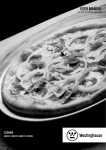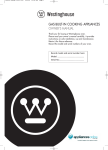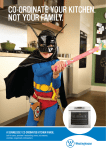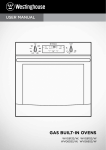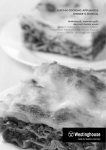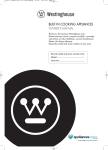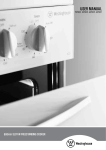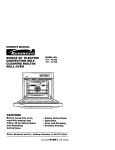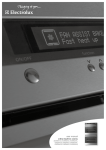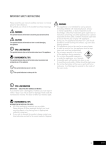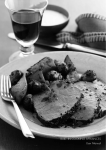Download Westinghouse GXP650 User manual
Transcript
USER MANUAL Gas Built-in Cooking Appliances COOKING Models: GOP474, GOP476, GGP475, GXP650 WMAN_541_Jun10.indd 1 4/6/10 10:18:28 AM contents congratulations contents Congratulations and thank you for choosing our oven. We are sure you will find it a pleasure to use. Before you use the oven, we recommend that you read through the relevant sections of this manual, which provides a description of your appliance and its functions. Description of your appliance . . . . . . . . . . . . 4 GOP474 . . . . . . . . . . . . . . . . . . . . . 4 GOP476 . . . . . . . . . . . . . . . . . . . . . 4 GGP475 . . . . . . . . . . . . . . . . . . . . . 4 GXP650 . . . . . . . . . . . . . . . . . . . . . . 4 Before operating your appliance for the first time . . . 5 Setting the time . . . . . . . . . . . . . . . . . . 5 Preparing your appliance for the first time . . . . . . . 5 Installing your oven accessories . . . . . . . . . . . 5 Using your oven . . . . . . . . . . . . . . . . . . 7 Understanding your oven functions . . . . . . . . . . 7 Cooling/venting fan . . . . . . . . . . . . . . . . 8 Operating sequence . . . . . . . . . . . . . . . . 8 Pre-heating your appliance . . . . . . . . . . . . . 8 Cooking with your timer . . . . . . . . . . . . . . . 9 2-Hour “auto off” timer . . . . . . . . . . . . . . 9 Electronic clock . . . . . . . . . . . . . . . . . . 9 Cooking guide . . . . . . . . . . . . . . . . . . 10 Oven shelf location . . . . . . . . . . . . . . . . 11 Choosing the best oven settings . . . . . . . . . . 11 Roasting meat . . . . . . . . . . . . . . . . . . 12 Roasting poultry and fish . . . . . . . . . . . . . . 12 Grilling guide . . . . . . . . . . . . . . . . . . 12 Grilling hints . . . . . . . . . . . . . . . . . . . 12 Guide to better grilling . . . . . . . . . . . . . . 13 Fan grill . . . . . . . . . . . . . . . . . . . . . 13 Dealing with cooking problems . . . . . . . . . . . 14 Cleaning your appliance . . . . . . . . . . . . . 15 Enamel . . . . . . . . . . . . . . . . . . . . . 15 Stainless steel . . . . . . . . . . . . . . . . . . 15 Glass . . . . . . . . . . . . . . . . . . . . . 15 Oven . . . . . . . . . . . . . . . . . . . . . 15 Grill . . . . . . . . . . . . . . . . . . . . . 15 Cleaning your oven accessories . . . . . . . . . . 15 Removing & replacing oven light . . . . . . . . . . 16 Getting to know your oven . . . . . . . . . . . . . 16 Electronic burner control . . . . . . . . . . . . . . 17 Solving problems . . . . . . . . . . . . . . . . . 18 Installation . . . . . . . . . . . . . . . . . . . . 19 Cabinet construction . . . . . . . . . . . . . . . 19 Gas installation information . . . . . . . . . . . . 20 Gas connection . . . . . . . . . . . . . . . . . 20 Appliances for operation on N.G. & S.N.G. . . . . . 20 Operating pressures . . . . . . . . . . . . . . . 21 Testing the operation of the appliance . . . . . . . . 21 Underbench ovens . . . . . . . . . . . . . . . . 22 Separate grill underbench . . . . . . . . . . . . . 23 Separate grill walloven . . . . . . . . . . . . . . 24 Door removal . . . . . . . . . . . . . . . . . . . 25 Notes . . . . . . . . . . . . . . . . . . . . . 26 Warranty . . . . . . . . . . . . . . . . . . . . 27 To avoid the risks that are always present when you use an appliance, it is important that the appliance is installed correctly and that you read the safety instructions carefully to avoid misuse and hazards. We recommend that you keep this instruction booklet for future reference and pass it on to any future owners. After unpacking the appliance, please check it is not damaged. If in doubt, do not use the appliance but contact your local customer care centre. Record model and serial number here: Model: Serial No: TIPS & INFORMATION Important – CHECK FOR ANY DAMAGES OR MARKS. If you find the oven is damaged or marked, you must report it within 7 days if you wish to claim for damage/marks under the manufacturers warranty. This does not affect your statutory rights. ENVIRONMENTAL TIPS Information on disposal for users • Most of the packing materials are recyclable. Please dispose of those materials through your local recycling depot or by placing them in appropriate collection containers. • If you wish to discard this product, please contact your local authorities and ask for the correct method of disposal. WMAN_541_Jun10.indd 2 4/6/10 10:18:28 AM safety Important safety instructions Please read the user manual carefully and store in a handy place for later reference. The symbols you will see in this booklet have these meanings: WARNING This symbol indicates information concerning your personal safety CAUTION This symbol indicates information on how to avoid damaging the appliance TIPS & INFORMATION This symbol indicates tips and information about use of the appliance ENVIRONMENTAL TIPS This symbol indicates tips and information about economical and ecological use of the appliance Meanings of symbols used in this manual are shown below: This symbol indicates never to do this This symbol indicates always do this WARNING Read the following carefully to avoid an accident. General warnings •This appliance is not intended for use by persons (including children) with reduced physical, sensory or mental capabilities, or lack of experience and knowledge, unless they have been given supervision or instruction concerning use of the appliance by a person responsible for their safety. •Children should be supervised to ensure that they do not play with the appliance. •During use, this appliance becomes hot. Care should be taken to avoid touching hot surfaces, e.g. oven door, heating elements or internal surfaces of the oven. •This appliance must not be used as a space heater. •In order to avoid a fire, the appliance must be kept clean and vents kept unobstructed. •Do not spray aerosols in the vicinity of the appliance during operation. •Do not store flammable materials in or under the appliance, e.g. Aerosols. •Accessible parts will become hot when in use. To avoid burns and scalds children should be kept away. •Do not line the bottom of the oven or grill with foil or cookware, it will damage the enamel. •Always use gloves when handling hot items inside grill or oven. •Do not modify this appliance. Grill •The grill door must be left fully open whilst grilling in a separate grill wall oven (GXP650 model). •The grill drawer must be left approximately two finger widths ajar whilst grilling in a separate grill underbench oven (GGP475 model). •Always turn the grill off immediately after use as fat left there may catch fire. •Do not cover the insert with foil, as fat left there may catch fire. •Always keep the grill dish clean as any fat left may catch fire. •Do not leave the grill on unattended. • To avoid a fire, ensure that grill trays and fittings are always inserted into the appliance in accordance with the instructions. •Do not place thick portions of food under the grill. Foods may curl, catch and ignite. •Accessible parts may become hot when grill is in use. Children should be kept away. Oven •During use the appliance becomes hot. Care should be taken to avoid touching the hot surfaces inside the oven. •Switch the appliance off before removing the oven light glass for globe replacement. • To avoid an accident, ensure that oven shelves and fittings are always inserted into the appliance in accordance with the instructions. •Do not use the door as a shelf. •Do not push down on the open oven door. Installation, cleaning and servicing •An authorised person must install this appliance. (Certificate of Compliance to be retained) •Before using the appliance, ensure that all packing materials are removed from the appliance. •In order to avoid any potential hazard, the enclosed installation instructions must be followed. •Ensure that all specified vents, openings and airspaces are not blocked. •Where the appliance is built into a cabinet, the cabinet material must be capable of withstanding 70°C •Only authorised personnel should carry out servicing. (Certificate of Compliance to be retained) •Always ensure the appliance is switched off before cleaning or replacing parts. •Do not use steam cleaners, as this may cause moisture build up. •Always clean the appliance immediately after any food spillage. • To maintain safe operation, it is recommended that the product be inspected every five years by an authorised serviceperson. This appliance must be earthed. 3 WMAN_541_Jun10.indd 3 4/6/10 10:18:28 AM features GOP474 1 2 3 4 1 Oven indicator light 3 Oven/Grill temperature selector 2 Function selector 4 2 hour ‘Auto-off’ timer GOP476 1 2 3 4 5 1 Function indicator light 3 Function selector 2 Oven indicator light 4 Electronic clock 5 Oven/Grill temperature selector GGP475 1 3 2 4 5 6 1 Oven indicator light 3 Function selector 5 Electronic clock 2 Grill indicator light 4 Oven temperature selector 6 Grill temperature selector GXP650 1 3 WMAN_541_Jun10.indd 4 2 4 5 6 1 Oven indicator light 3 Function selector 5 Electronic clock 2 Grill indicator light 4 Oven temperature selector 6 Grill temperature selector 4/6/10 10:18:29 AM operation BEFORE OPERATING YOUR APPLIANCE FOR THE FIRST TIME SETTING THE TIME If you have purchased a model fitted with an electronic clock, you must set the time of day before you can operate your appliance. Electronic Clock • After the appliance has been electrically connected “12.00” will be displayed and the “clock” indicator will flash. • To set the time of day, press the – or + symbols. 5 seconds after the last change, the “clock” indicator will disappear, confirming the time has been set. Preparing your appliance for the first time Installing your oven accessories 1. Side racks The side racks that come with your oven can be attached to either side of your oven. •Insert the largest peg into rear access hole provided. See diagram. •Then locate the front peg into the front access hole and push in firmly. rear Note: The clock has a 24-hour display. front ALL MODELS • P lease remove all internal boxes and bags from the oven before operation. • Please wipe out the oven interior prior to operation with warm soapy water and polish dry with a soft clean cloth. Do not close the oven door until the oven is completely dry. • If your appliance is fitted with a 2-hour “Auto Off” timer, make sure it is set to “Off” marker for manual operation. See image. rear GXP650 front 5 WMAN_541_Jun10.indd 5 4/6/10 10:18:29 AM operation BEFORE OPERATING YOUR APPLIANCE FOR THE FIRST TIME 2. Shelves and trays The shelves are designed so that they have maximum travel but cannot be accidentally pulled right out. The trays are designed the same way and fit straight into the side racks. • Locate the rear edge of the shelf/tray in between 2 guide rails of the side rack - see diagram. Ensure the same rail positions on both sides of the oven are being engaged. •With the front edge raised, begin to slide the shelf into the oven. •Once the detents have passed the front edge of the side rack, the shelf can be pushed completely in. • When fully inserted the shelf/tray should not interfere with the closed oven door. • To insert the grill tray in a separate grill underbench (GGP475 model), fully open the grill drawer and position the tray so that the slots on the outer edges fit on the tabs on the slides. Separate grill underbench (GGP475) WMAN_541_Jun10.indd 6 4/6/10 10:18:30 AM operation using your OVEN Understanding your oven functions Your oven will have a selection of the following functions. Refer to “Description of your appliance” (page 4) to confirm what functions are available to you. Oven Refer to cooking guide for more information. Fan Bake Heat comes from the gas “base heat” burner which is then circulated by the fan. This fan circulates the hot air around the oven cavity so that you can put your food in different places in the oven and still cook them at the same time. You can use the “fan bake” function for multi-shelf cooking, reheating cooked foods, pastries and complete oven meals. It will cook at a lower temperature and be faster than baking. Please note that some variation in browning is normal. Bake Heat comes from the gas “base heat” burner below the food. The bottom burner is below the floor of the oven which is controlled by the thermostat and will turn on and off to maintain the set temperature. You can use the “bake” function for single trays of biscuits, scones, muffins, cakes, slices, casseroles, baked puddings, roasts and delicate egg dishes. – For best results use silver or shiny trays. Defrost The “defrost” function uses low temperature air which is circulated by the fan. You can defrost (thaw) your food before you cook it. Also you may use your “defrost” to raise your yeast dough or to dry fruit, vegetables or herbs. Grill Refer to grilling guide for more information. Grill (grill in oven GOP474, GOP476 models only) The “grill” directs radiant heat from the powerful upper element onto the food. You can use the “grill” function for tender cuts of meat, steak, chops, sausages, fish, cheese toasties and other quick cooking foods. Grill with the oven door closed. Preheat your grill for 3 minutes to get the best results. This will help seal in the natural juices of steak, chops etc. for a better flavour. You can slide your grill dish into either of the 2 spaces within the upper pairs of support rails. Fan Grill (grill in oven GOP474, GOP476 models only) “Fan grill” offers you the benefits of both “bake” and traditional “grill” functions. The grill element turns on and off to maintain the set temperature while the fan circulates the heated air. The oven door remains closed for fan grill. You can use “fan grill” for large cuts of meat in the oven which gives you a result that is similar to “rotisserie” cooked meat. Put your food on a shelf in the second lowest shelf position. Put the grill dish on the lowest shelf position to catch any spills. When using “fan grill” it is not necessary to turn the food over during the cooking cycle. Set temperature to 180°C. Separate Grill (GGP475, GXP650 models only) The “grill” directs radiant heat from the powerful upper element onto the food. You can use the “grill” function for tender cuts of meat, steak, chops, sausages, fish, cheese toasties and other quick cooking foods. . Preheat your grill for 3 minutes to get the best results. This will help seal in the natural juices of steak, chops etc. for a better flavour. For models with a drop down grill door (GXP650), the door must be left open while grilling. For models with a slide out grill drawer (GGP475), the grill drawer should be left open approx. two finger widths ajar. 7 WMAN_541_Jun10.indd 7 4/6/10 10:18:30 AM operation using your OVEN Cooling/Venting fan Your built-in appliance is fitted with a cooling fan. This prevents your kitchen cabinet from overheating and reduces the condensation inside the oven. It will operate whenever you are using your oven or grill and will blow warm air across the top of the oven or grill door. In some appliances the cooling fan may continue to operate after the appliance is turned off, it will switch off by itself once oven is cool. Operating Sequence WARNING If you have purchased a model fitted with an electronic clock you must set the time of day before you can operate your appliance. Select the cooking function Turn the “function selector” in any direction to select the desired function. Pre-heating your appliance For best results when baking you must preheat your oven for 30 minutes. Preheat grill for 3 minutes to obtain best results. Pre-heating your appliance allows it to reach the required temperature quickly and efficiently. When baking bread or cakes, load the oven as quickly as possible after pre-heating, only leaving the oven door open for the shortest time. This will minimise loss of heat from the oven and ensure the best results. With “bake” 1. It is recommended you preheat your appliance when cooking or baking. 2. Set the desired preheat temperature, by rotating your oven temperature selector. When the indicator light goes out the oven has reached the desired preset temperature, place your food into the oven, close the door and set the timer if you desire. With “grill” Preheat the grill for at least 3 minutes to obtain best results. This will help to seal the natural juices of steak, chops and other meats for a better flavour. Setting temperatures The following table displays the temperature settings for recipes which do not show actual temperatures. Select the Temperature To set the temperature, turn the temperature selector in a clockwise direction to the desired setting. The “oven indicator light” will come on and the oven burner will ignite. A thermostat controls the temperature in the oven. When the set temperature is reached, the GAS burner flame goes out and the indicator light goes off. When the oven temperature falls below the set temperature the flame automatically re-ignites and the “oven indicator light” comes on again. Once the food is cooked, turn the “oven temperature selector” back in an anti-clockwise direction. Do not force it right round in a clockwise direction as this will result in damage to the oven. Turn the “function selector” back to “Off”. NOTE: The cooking function must be selected before the oven will operate. Once the function has been selected, use the temperature selector to set the cooking temperature. WMAN_541_Jun10.indd 8 Conversion Table Verbal Drying Celsius 0C Fahrenheit 0F Gas Mark 80 - 90 175 - 195 n/a 95 - 130 200 - 265 1/4 - 1/2 Slow/low 135 - 150 275 - 300 1-2 Moderately slow / warm 160 - 170 320 - 340 3 Moderate / medium 180 350 4 Moderate / moderately hot 190 375 5 Moderately hot 200 390 6 Hot 220 430 7 Hot / very hot 230 450 8 Very hot 250 480 9 Extremely hot 260 500 10 Very slow/very low 4/6/10 10:18:30 AM operation cooking with your timer 2-hour “Auto Off” timer The 2-hour timer features an automatic oven “cut off”. This means that a cooking period of up to 120 minutes can be set. When the timer has counted back to “Auto Off” a bell will sound and the oven will automatically switch off. Setting the time of day You must set the time of day before you can operate your appliance. When power is supplied to your oven “12.00“ will be displayed and the “clock” indicator will flash. 1.To set the time of day in hours and minutes, press – or +. 5 seconds after the last change, the “clock” indicator will disappear, confirming the time has been set. NOTE: The clock has a 24-hour display. Once automatic baking is complete, return to manual operation by setting the timer to the ‘OFF’ mark. NOTE: It is not recommended to use this timer for short durations (e.g. boiling eggs). Operating the electronic clock Electronic Clock Touch Control Change the time of day (Daylight saving) begins 1.Press “mode” until the “clock” indicator flashing. 2.Press – or + to change the time. 5 seconds after the last change, the “clock” indicator will disappear, confirming the time has been set. Setting the timer 1.Press “mode“ until the “timer” indicator begins flashing. 2.Set the countdown time you want by using – and +. 5 seconds after the last change the “timer” indicator will stop flashing, confirming the timer has been set. 3.To stop the beeper, press –, + or “mode”. Setting the cooking duration 1.Check the clock displays the correct time of day. 2.Select the desired oven function and temperature. The oven indicator light will glow and the heating source will come on. 3.Press “mode“ until the “cook time” indicator begins flashing. 4.Set the cooking duration you want by using – or +. 5 seconds after the last change, the “cook time” indicator will stop flashing, and the time of day will be displayed. NOTE: Do not forget to add preheating time if necessary. General features Your touch control clock has the following features: • Timer – allows you to set a countdown time that will beep when the set time has elapsed. • Cooking duration – You can set a cooking duration. A timer will count down the preset cooking time, beep when the time has elapsed and turn the oven off. • End cooking time – you can set a cooking finish time. A timer will count down the preset cooking time, beep when the finish time has been reached and turn the oven off. • Delayed start cooking time – You can combine the cooking time and stop cooking time to switch the oven on and off at a specific time during the day. Setting the cooking end time 1.Check the clock displays the correct time of day. 2.Select the desired oven function and temperature. The oven indicator light will glow and the heating source will come on. begins 3.Press “mode“ until the “end time” indicator flashing. 4.Enter the time of day you want to finish cooking by pressing – or +. 5 seconds after the last change, the “end time” indicator will stop flashing and the current time of day will be displayed. NOTE: Your touch control clock only operates with your main oven. 9 WMAN_541_Jun10.indd 9 4/6/10 10:18:30 AM operation Operating the electronic clock (CONT.) COOKING GUIDE Setting the delayed start cooking time 1.Program the “cook time“ and “end time“ as described in the relevant sections. Once both the “cook time“ and “end time“ have been set, the “cook time“ and “end time” indicators will stop flashing and the current time of day will be displayed. Setting the delayed start cooking time 1.Program the “cook time“ and “end time“ as described in the relevant sections. Once both the “cook time“ and “end time“ have been set, the “cook time“ and “end time” indicators will stop flashing and the current time of day will be displayed. • Select the correct shelf location for food being cooked. • Make sure dishes will fit into the oven before you switch it on. • Keep edges of baking dishes at least 40mm from the side of the oven. This allows free circulation of heat and ensures even cooking. • Do not open the oven door more than necessary. • Do not place foods with a lot of liquid into the oven with other foods. This will cause food to steam and not brown. • After the oven is turned off it retains the heat for some time. Use this heat to finish custards or to dry bread. • Do not use a lot of cooking oil when roasting. This will prevent splattering oil on the sides of the oven and the oven door. Polyunsaturated fats can leave residue which is very difficult to remove. • When cooking things which require a high heat from below (e.g. tarts), place the cooking dish on a scone tray in the desired shelf position. • For sponges and cakes use aluminium, bright finished or non-stick utensils. To check or cancel settings 1.To check your settings, press “mode” until the setting you want is displayed. A red light will flash next to the mode (cook time, end time etc) that is currently on display. 2.To cancel “delayed start” press “mode” until a light flashes next to “end time”. Press and hold “–” until the clock no longer reverses (“0:00” and you will hear a beep). If you have left the temperature and function knobs at a setting the oven will start once the “end time” light stops flashing. 3.To cancel “auto shut off” press “mode” until a light flashes next to “cook time”. Press and hold “–” until the clock no longer reverses (“0:00” and you will hear a beep). This automatically cancels “delayed start”. If you have left the temperature and function knobs at a setting, the oven will start once the “cook time” light stops flashing. Because you have cancelled “auto off” the oven will continue to heat until you manually turn it off. On completion of cooking The oven will turn off, the timer will beep and the “end time” and/or “cook time” indicators will flash. 1.Turn the function and temperature controls to the off position. 2. Press “+” or “–” or “mode” to stop the timer from beeping. Oven shelf location Your oven has five positions for shelves. These are numbered from 1 (the lowest shelf position) to 5 (the highest shelf position). See diagram. To give maximum space above and below the shelves, load them in this way: • When cooking with 1 shelf, use position 3. • When cooking with 2 shelves, use position 2 and 5. Use the oven efficiently, by cooking many trays of food at the same time. For example: • Cook 2 trays of scones, small cakes or sausage rolls. • Cook a roast dinner at the same time as you cook chips or vegetables. Switching the clock display ON and OFF 1.Press together “+” and “–” for 2 seconds to switch ’off’ the display. 2.Press together “+” and “–” for 2 seconds to switch the clock display ’on’ again. Note: If a timer mode is set, then it is not possible to switch the display off. 5 4 3 2 1 5 Position Rack WMAN_541_Jun10.indd 10 4/6/10 10:18:31 AM operation COOKING GUIDE Choosing the best oven settings The following table is intended as a guide and experience may show some variation in cooking times necessary to meet individual requirements. For best results when baking you must preheat your oven for 30 minutes. Models without oven fan FOOD TEMPERATURE 0C OVEN POSITION IN SHELF* TIME IN MINUTES Scones Plain or fruit 220 2 10 - 15 Biscuits Rolled 180 2 10 - 15 Spooned 190 2 12 - 15 Shortbread biscuits 160 1 or 2 30 - 35 Hard - individual 110 2 90 Soft - individual 180 2 15 - 20 Pavlova - 6 egg 110 1 75 Patty Cakes 190 3 15 - 20 Sponge - 4 egg 180 2 20 - 30 Shallow butter cake 180 2 30 - 40 Rich fruit cake 150 2 180 Cornish pasties 200/180 2 40 - 45 Custard tart 200/180 1 10/20 - 30 Pastry choux Cream puffs 210 2 25 - 30 Yeast goods Bread 210 1 25 - 30 TEMPERATURE 0C OVEN POSITION IN SHELF* TIME IN MINUTES Meringues Cakes Pastry - shortcrust * Counting from the bottom shelf up. Models with oven fan FOOD Scones Plain or fruit 210 Any 10 - 15 Biscuits Rolled 170 2&4 10 - 15 Spooned 180 2&4 12 - 15 Shortbread biscuits 150 2&4 30 - 35 Hard - individual 100 Any 90 Soft - individual 165 Any 15 - 20 Meringues Pavlova - 6 egg 100 Any 75 Patty Cakes 180 2&4 15 - 20 Sponge - 4 egg 170 2 20 - 30 Shallow butter cake 170 2&4 30 - 40 Rich fruit cake 130 2 180 Cornish pasties 180/160 2 40 - 45 Custard tart 190/170 2 20 - 30 Pastry choux Cream puffs 200 2&4 25 - 30 Yeast goods Bread 200 Any 25 - 30 Cakes Pastry - shortcrust * Counting from the bottom shelf up. Refer to “oven shelf location” section for more detailed information. 11 WMAN_541_Jun10.indd 11 4/6/10 10:18:31 AM operation COOKING GUIDE GRILLING GUIDE Roasting Meat 1. Place the meat in the oven and set the temperature between 180°C and 200°C. (It is recommended to wrap your meats in an oven roasting bag or foil to prevent fats and oils from splattering, making it easier to clean your oven.) 2. Use the grill / oven dish and smokeless grill insert. Place the meat on the insert. 3. Do not pierce the meat, as this will allow juices to escape. 4. When the meat is cooked, take the roast out of the oven, wrap in aluminum foil and leave to stand for about 10 minutes. This will help retain the juices when the meat is carved. The table shows temperatures and cooking times for different kinds of meat. These may vary depending on the thickness or bone content of the meat. Grilling hints MEAT Beef RECOMMENDED TEMPERATURE 0C 200 DESCRIPTION DOOR POSITION DURING GRILLING Underbench Grill in oven models Door FULLY closed Separate grill underbench Slide out grill drawer Drawer 2 finger widths ajar Drop down grill door Door FULLY open Rare 35 - 40 Medium 45 - 50 Separate grill walloven Well done 55 - 60 Duo walloven Duo oven Door FULLY closed Medium 40 Double oven Grill in oven Door FULLY closed Well done 60 Veal 180 Well done 60 Pork 200 Well done 60 Roasting poultry and fish 1. Place the poultry or fish in an oven set at a moderate temperature of 180°C. 2. Place a layer of foil over the fish for about three quarters of the cooking time. The table shows temperatures and cooking times for different kinds of fish and poultry. These may vary depending on the thickness or bone content of the meat. RECOMMENDED TEMPERATURE 0C MINUTES PER KILOGRAM 180 45 - 50 Duck 180 - 200 60 - 70 Turkey 180 Fish 180 WMAN_541_Jun10.indd 12 PRODUCT TYPE MINUTES PER KILOGRAM 200 Chicken As a method of cooking, grilling can be used to: • Enhance the flavours of vegetables, fish, poultry and meat. • Seal the surface of the food and retain the natural juices. Note: Below is a table indicating the door position whilst grilling for each of the product types. RESULT Lamb MEAT WARNING Always clean the grill / oven dish after every use. Excessive fat build up may cause a fire. This table shows how to grill different types of meat: MEAT METHOD Beef You can use tenderloin, rump, sirloin. Brush with oil or melted butter, especially if the meat is very lean. Lamb You can use loin chops, shortloin chops, chump chops, and forequarter chops. Remove skin or cut at intervals to stop curling. Brush with oil or melted butter. Sausages Prick sausages to stop skin from bursting. Fish Brush with oil or melted butter and lemon juice. Bacon Remove rind. Grill flat and make into rolls. 40 - 45 (<10kg) 35 - 40 (>10kg) 20 4/6/10 10:18:31 AM operation GRILLING GUIDE Guide to better grilling No definite times can be given for grilling because this depends on your own tastes and the size of the food. These times should only be used as a guide and remember to turn the food over half way through the cooking process. For better grilling results, follow these easy instructions: 1. Remove oven / grill dish and smokeless grill insert and preheat grill for about 3 minutes. 2. Choose only prime cuts of meat or fish. If the cut is less than 5mm thick it will dry out. If the cut is more than 40mm thick, the outside may burn whilst the inside remains raw. 3. Do not place aluminium foil under the food as this prevents fats and oils from draining away, which could result in a fire. 4. Baste the food during cooking with butter, olive oil or marinade. Grilled food is better if marinated before cooking. 5. Use tongs to turn food as a fork pierces the surface MEAT TIME Steak 15 - 20 minutes Chops 20 - 30 minutes Fish 8 - 10 minutes Bacon 4 - 5 minutes Fan Grill (Multifunction grill in oven models only) If your appliance has fan grill as a function, this will assist the grilling process by circulating the heat evenly around the food. The recommended temperature setting is 180°C for all fan grilling functions. 1. Use the smokeless grill insert and oven dish for all fan grilling. 2. Position the dish in the lower half of the oven, for best results. 3. Wipe off any oil or fat which spatters while the oven is still warm. There is no need to turn the meat as both sides are cooked at the same time which means that the food is succulent. 13 WMAN_541_Jun10.indd 13 4/6/10 10:18:31 AM TROUBLESHOOTING dealing with cooking PROBLEMS (see also p.18) problem Uneven cooking Baked products too brown on top Baked products too brown on bottom Cakes have a cracked, thick crust Baked products are pale, flat and undercooked Cake fallen in the centre Roast meat and potatoes not browning in fan oven CAUSES REMEDY Incorerct shelf position Select shelf that places food in the centre of the oven Oven tray too large Experiment with other trays or dishes Trays not centralised Centre trays Air flow in oven uneven Rotate food during cooking Grill dish affecting thermostat Remove grill dish from oven on bake modes Oven not preheated Preheat the oven Baking tin too large for the recipe Use correct size tins Baking tins not evenly spaced Stagger baking tins at least 3cm between tins and the oven walls Products not evenly sized or spaced on trays Ensure products are same size and shape and are evenly spaced over trays Baking temperature too high Lower the temperature Baking tin too large for the recipe Use correct size tins Baking tins are dark metal or glass Change to shiny, light tins or lower the temperature by 10°C Food too low in the oven Cook one shelf higher Oven door opened too frequently during baking Don’t open the oven door until at least half of the cooking time has passed Baking temperature too high Lower the temperature Grill dish affecting thermostat Remove grill dish from oven on bake modes Baking temperature too high Lower the temperature Food too high in the oven Cook one shelf lower Cake batter over-mixed Mix just long enough to combine ingredients Pan too deep Check size of pan and use recommended size Baking tins are dark metal or glass Change to shiny, light tins Baking temperature too low Raise the temperature Food too low in the oven Cook one shelf higher Baking time too short Increase cooking time Incorrect tin size Use correct tin size Baking temperature too low Raise the temperature Baking time too short Increase cooking time Proportions of ingredients incorrect in the recipe Check recipe Opening door too early in baking Do not open the door until the last quarter of cooking time Poor hot air circulation Elevate food onto a rack to allow air circulation Grill dish affecting thermostat Remove grill dish from oven on bake modes Juices running out of meat Do not pierce meat with fork, turn with tongs Grilled meats overcooked on outside and raw in centre Grill at lower insert position Grilled chops and steaks curling Cut into fat every 2cm (1/2 inch) WMAN_541_Jun10.indd 14 4/6/10 10:18:31 AM CLEANING CLEANING YOUR APPLIANCE WARNING • Always make sure that the oven is electrically isolated before cleaning. This can be done via the power point switch located nearby. • Do not use steam cleaners. • Do not line the bottom of the oven or grill with foil or cookware. • Do not use sharp metal implements or utensils on any surface, as these may leave permanent scratches or marks. Enamel • Rub persistent stains vigorously with a nylon scourer or creamed powder cleansers. NOTE: You can also use household oven enamel cleaners - follow the manufacturer’s instructions carefully. • Do not use harsh abrasive cleaners, powder cleaners, steel wool or wax polishes. Stainless steel All grades of stainless steel can stain, discolour or become greasy. You must clean these areas regularly by following the procedures below, if you want your appliance to look its best, perform well and have a long life. Separate Grill (GGP475, GXP650 models only) • Always keep the grill dish and grill dish insert clean, as any fat deposits may catch fire. • Ensure that fats and oils do not accumulate around the grill element. The grill element can be released to assist in cleaning the top of the grill cavity (refer to page 16). Cleaning your oven accessories Removing the trays and shelves from your appliance • Slide the dish and shelves towards you until they reach the front stop. • Tilt them up at the front to clear the side supports, taking care not to spill the contents. • For separate grill underbench model (GGP475), pull the grill drawer out to it’s full extent. Carefully lift the dish from the support. • Lift the dish and shelves clear. • Wash the dish and insert the shelves in hot soapy water. • Reverse the above steps to put the grill dish and shelves back again. • Ensure that they are placed between the 2 support wires. See page 6 for more details. CAUTION Care must be taken when wiping exposed stainless steel edges.…they can be sharp! Your stainless steel appliance is manufactured from a mark resistant stainless steel. This special stainless steel resists marks such as finger prints and water spots. To keep your stainless steel appliance looking at its best, you should clean it regularly. Wash with warm soapy water and rinse with clean water. Wipe with clean water and a soft clean cloth to remove soap residue. NOTE: Make sure you follow the polish or brushing lines in the steel. CAUTION DO NOT use stainless steel cleaners, abrasive pads or other cleaners as they are likely to scratch the surface. Damage due to poor cleaning technique is not covered by your warranty. Glass • Glass surfaces on doors and control panels are best cleaned immediately after soiling. • A damp cloth may help remove baked on food deposits. • Oven cleaners can be used to remove stubborn marks and stains. Oven • Always keep your appliance clean. Ensure that fats and oils do not accumulate around elements, burners or fans. • Always keep the oven dish, baking trays, grill dish and grill dish insert clean, as any fat deposits may catch fire. • Always wrap your meats in foil or an oven roasting bag to minimise cleaning. Any polyunsaturated fats can leave a varnish-like residue which is very difficult to remove. • The upper element can be released to assist in cleaning (refer to page 16). Removing the side racks (shelf supports) – grill in oven and separate grill models • Grasp the shelf supports at the front. • Pull them firmly inwards. • To install the side racks, see page 5. CAUTION DO NOT remove the separate grill drawer mechanism on the separate grill underbench model (GGP475). The grill dish can be easily removed for cleaning. 15 WMAN_541_Jun10.indd 15 4/6/10 10:18:32 AM MAINTENANCE MAINTAINING YOUR APPLIANCE GET TO KNOW YOUR OVEN Releasing the grill element – grill in oven and separate grill models We have designed the upper element with a hanger clip to help you reach your cavity roof for cleaning. To remove grill, push sides of hanger clip in the direction of arrows until one hanger clip can easily be removed from retaining hole. To replace, reverse the process. Get to know your new oven with this ‘Simple Test Cake’ Although we strive for a perfect performing oven, it’s possible that there will be some variation in colour when baking. Therefore, we suggest this simple, easy and delicious to make Simple Test Cake, it can help you understand your new oven. All ovens do sometimes have hot or cold spots, therefore it is important to judge with your eye as you may require to rotate during baking. ‘Simple Test Cake’ 125g butter, softened to room temperature 1 cup caster sugar 1 teaspoon pure vanilla essence 4 large eggs 2 cups self-raising flour pinch of salt 4 tablespoons (80mL) full-cream milk Grill in oven model shown. The grill element in separate grill models has the same hanger clip arrangement in the grill compartment. Removing and replacing the oven light •Turn oven light glass anticlockwise to remove it for globe replacement. • A special high temperature resistant globe should be used. This can be purchased from the Customer Care Centre. WARNING Make sure the appliance is turned off before you remove or replace parts, to avoid the possibility of electric shock. Method: 1.Butter base and sides of two, 20cm straight-sided round or square cake pans. Then line the base with grease proof or baking paper. 2.Preheat oven to moderate ‘180ºC’ (170ºC fan forced) and ensure oven shelf is in the centre position of oven. 3.Cream softened butter and sugar until light in colour. 4.Add vanilla essence. 5.Then eggs one at a time, beating well after each addition. 6.Sift flour and salt into the mixture and beat until well combined. 7.Add milk and beat or stir to combine. 8.Spoon mixture equally between prepared cake pans. 9.Bake in preheated oven, middle shelf for about 25 to 35 minutes or until when tested with a fine cake skewer it comes out clean or the edges of the cakes have come away slightly from the sides of the cake pans. 10.Remove from oven to wire cake rack and rest for 5 minutes before removing from cake pans. Cool completely. To Serve: sandwich together with your favourite jam or conserve, and dust top with pure icing sugar. NOTE: if desired substitute butter for either margarine or olive oil spread. Recipe is based on the Australian standard metric 250mL cup and 20mL tablespoon sets WMAN_541_Jun10.indd 16 4/6/10 10:18:32 AM SAFETY ELECTRONIC BURNER CONTROL Your gas oven is fitted with an electronic controller which manages the operation of the burner and monitors the flame. This controller includes features which ensure the safe operation of your appliance and will prevent the build up of unburnt gas, should a fault occur. It is normal for the flame to turn on and off during cooking, to maintain a stable temperature in the oven. The Thermostat Indicator Light indicates when the flame is on or igniting (indicator glows), or when the flame is off (indicator off). The burner flame can be seen by viewing through the 2 holes in the front of the burner cover. Ignition and Response to Ignition Failure The controller will attempt to ignite the flame when an oven function is selected and the Thermostat turns on (indicator light changes from off to on). The controller will make up to 2 attempts to ignite the flame, stopping if a flame is detected by the controller. If by the end of the 2 attempts a flame is not detected then the burner and ignition will be turned off and a delay of 90 seconds will be observed. During this delay the controller will not respond to the Function and Thermostat controls. At the end of this delay, switch the Thermostat or Function Selector off and leave off for at least 5 seconds. Then switch the Thermostat and Function Selector on again to re-attempt ignition. If the oven controls are left on when the delay ends then ignition will not be attempted until the Thermostat or Function Selector is first turned off for 5 seconds. Recognising a Safety Shut-down Condition During normal cooking the Thermostat indicator light is on when the burner flame is igniting or on, and the Thermostat indicator light is off when the flame is off. If an oven function is selected and the Thermostat light is on, but the flame is not on or attempting to ignite then the controller has invoked a safety shutdown of the burner. A 90 second delay is observed from the time the shut-down occurred before the controller will respond to the oven controls. Once the delay period has ended the Thermostat or Function Selector must be turned off for at least 5 seconds before oven functions can resume. Power Failure In the event of an interruption to mains power, the restoration of power will not cause the burner to ignite if the controls were left on. However the grill element will resume heating on models which do not have an electronic clock. To resume operation of the appliance after a power interruption: • First turn the Function Selector or Thermostat controls to the off position. The controls must remain in this position for at least 5 seconds • If the appliance has an electronic clock then set the time of day on the electronic clock. Normal operation of the appliance may now resume. Response to Flame Failure If the controller cannot detect flame due to a fault, then the controller will respond •firstly by attempting to re-light the burner with a sequence of up to 3 attempts and •If the re-lighting sequence is not successful the burner will be shut off. The re-lighting sequence will include up to 3 attempts to re-light the burner, stopping if a flame is detected by the controller. If by the end of the re-lighting sequence a flame is not detected then the burner and ignition will be turned off and a delay of 90 seconds will be observed. During this delay the controller will not respond to the Function and Thermostat controls. At the end of this delay, switch the Thermostat or Function Selector off and leave it off for at least 5 seconds. Then switch the thermostat and Function Selector on again to re-attempt ignition. If the oven controls are left on when the delay ends then ignition will not be attempted until the Thermostat or Function Selector is first turned off for 5 seconds. 17 WMAN_541_Jun10.indd 17 4/6/10 10:18:32 AM TROUBLESHOOTING SOLVING PROBLEMS Faults If there is a problem with the oven and/or grill, please: • Check the points listed below before calling for service. It may be possible to avoid a call by fixing the problem yourself - and so continue cooking. • For cooking problems refer to page 14. NOTE: We may charge for service even in the guarantee period if your problem is due to the causes listed below. Data Plate When you need information, service or replacement parts please: • Tell us the 1. Model, 2. Model Number & 3. Serial Number shown on the data plate. The data plate is visible when the oven or grill door is open. If you need more information, please contact the Customer Care Centre on 1300 363 640 (Australia - Centre is open 8.00am - 5.00pm M - F Eastern Standard Time) or +649 573 2384 (New Zealand - Centre is open 8.00am – 5.00pm M - F). If you have a warranty or spare parts enquiry, you should call the number listed on the back page. PROBLEM POSSIBLE CAUSE Oven or grill not working - Time of day not set. - Power not turned on. - Gas supply turned off or LPG bottle empty. - Controls are incorrectly set. - Household fuse has blown or power supply is off. NOTE: If the household fuse continues to blow, call the Customer Care Centre. Oven light not working - Lamp blown or loose in socket. - Household fuse has blown. NOTE: If the household fuse continues to blow, call the Customer Care Centre. Oven not heating enough - Foil or trays on bottom of oven. - Timer is in “AUTO” mode. (Refer to timer operating instructions) - Household fuse has blown. NOTE: If the household fuse continues to blow, call the Customer Care Centre. Oven not working - Gas supply turned off or LPG bottle empty. - The oven safety shutdown has enacted. Reset the controls, wait 90 seconds and then re-start the oven. NOTE: If safety shutdown persists, call the Customer Care Centre. Timer flashing on - Power failure or interruption. display NOTE: Reset time of day and any cooking functions you were using. (Refer to TIMER operating instructions). Unit smoking when - Protective oils being removed. first used Door cannot be replaced after removal - Stirrup not engaged properly. Excessive heat or condensation on control panel or knobs - Check cooling fan is working by feeling for air movement at top of oven door. If no air movement is detected, call the Customer Care Centre. NOTE: Only authorised personnel should carry out servicing. WMAN_541_Jun10.indd 18 4/6/10 10:18:32 AM INSTALLATION INSTALLING YOUR APPLIANCE WARNING Use an authorised person. As stated in the local municipal building codes and other relevant statutory regulations. • Refer to data plate for rating information and circuit diagram. The data plate is positioned behind the bottom of the oven door. The circuit diagram is positioned on the top panel of the appliance. WARNING This appliance must be properly earthed • Do not lift the appliance by the door handles. • Prepare the cupboard opening to match your appliance measurements. (See diagrams). • Slide appliance into the cupboard, ensuring that the supply cable (where fitted) does not kink. • To prevent tipping, use the screws supplied to secure your oven into the cupboard. Use just 2 screws for underbench and separate grill underbench ovens, and 4 screws for separate grill wallovens. Remove the bottom door in separate grill wallovens to provide access to the bottom 2 screwing points (see illustrations on page 21). • For appliances fitted with a flexible supply cord, if the cord is damaged, it must be replaced by the manufacturer or its service agent or similarly qualified person in order to avoid a hazard. The plug must be accessible after installation. • Where the appliance is built into a cabinet, the cabinet material must be capable of withstanding 70°C. Installation into low temperature tolerant cabinetry (e.g. vinyl coated) may result in deterioration of the low temperature coating by discolouring or bubbling. • If the appliance is installed adjacent to vinyl-wrapped surfaces, use an installation kit available from the vinylwrap supplier. • Electrolux Home Products cannot accept responsibility for damage caused by installation into low temperature tolerant cabinets. • After installation, test and ensure that the appliance operates correctly before handing it over to the customer. It is recommended that this product is not installed in an unvented living space, particularly if that space incorporates sleeping quarters. CAUTION To avoid any potential hazard, you must follow our instructions below when you install your appliance. Failure to install the appliance correctly could invalidate any warranty or liability claims and lead to prosecution. This appliance is only suitable for connection to fixed consumer piping where the fault pressure is limited to 14kPa or less. Refer clause 4.6.1 of A.S. 5601. Cabinet Construction for your appliance For the best integration within a kitchen, install this appliance in a standard 600mm wide cupboard that gives a flush fit with the surrounding cupboard fronts (figure A). A recess of 20 mm is ideal. It can also be installed using a proud fit with the surrounding cupboard (figure B). NOTE: Your appliance must be mounted on a flat surface for the full width and depth of the product. Infill panel 20mm Cupboard door Cleat Cupboard door Figure A - Flush fit (top view) Cupboard front Figure B - Proud fit (top view) 19 WMAN_541_Jun10.indd 19 4/6/10 10:18:33 AM INSTALLATION GAS INSTALLATION INFORMATION Gas Connection Before commencing installation, check to ensure the type of gas to which the appliance is intended to be connected matches the gas type given on the appliance data plate. Check the data plate (located behind the oven door) to determine gas type. A gas type label is located on the back panel near the gas inlet. A 1700mm long flexible hose is supplied in the pack for installation purposes. Connecting flexible hose • Place a spanner on the flats provided on the gas inlet to brace the inlet against the action of wrenching when connecting the hose to the appliance gas inlet. Failure to do so may damage the appliance. • An approved thread sealing tape or compound is required for the connection between the hose and the appliance gas inlet. Appliances for operation on N.G. & S.N.G. For N.G. and S.N.G appliances the supplied N.G. regulator must be fitted. For L.P.G appliances (Propane or Universal LP) the test point fitting supplied must be fitted. NOTE: The inlet of the regulator or test point fitting should be fitted to the consumer piping first. The arrow on the regulator or test point fitting indicates the direction of gas flow. Then connect the hose to the outlet of the regulator or test point fitting using the swivel connection on the hose and fibre washer supplied. Ensure the regulator or test point fitting is in a position that is accessible with the appliance installed and which will allow the appliance to be withdrawn without disconnecting the hose. Check all joints and ensure that connections are sound. N.G. Regulator (P/No. 294-001-031) Internal flange Important: flat fibre washer must be installed (P/No. 115-009-011) Gas flow to appliance WMAN_541_Jun10.indd 20 4/6/10 10:18:33 AM INSTALLATION GAS INSTALLATION INFORMATION Operating Pressures Supply and operating pressures for various gases and corresponding injector sizes for each burner. SUPPLY PRESSURE (kPa) NOMINAL TEST POINT PRESSURE (kPa) Oven injector NG & SNG 1.13 - 5.00 1.00 1.50 Universal LP 2.75 2.75 0.82 GAS TYPE Testing the Operation of the Appliance This product has an Electronic Burner Control with a flame safeguard system, which includes a safety shutdown function that operates when the presence of a flame is not detected within a prescribed period. It may be necessary to interrupt the operation of the control system in order to facilitate purging of air from the appliance. During the purging procedure the product should be closely monitored to ensure that the ignition spark can be observed through the round hole in the left hand side of the cover on the bottom of the oven, and that the solenoid valve can be heard to open and close. 1. After connecting the gas and leak testing the gas connection, plug in the service cord and turn on the power. 2. Set the time of day clock (if fitted). 3. Purging procedure: a. Turn on the oven b. The unit will commence sparking and the solenoid valve will open for a short period. If a flame is not established, the controller will shut the solenoid valve and stop sparking, then pause for a moment before repeating this cycle. At this point if there is still no flame, the control system will go into safety shutdown. c. If the control system does go into safety shutdown, turn off all the controls and switch off the power supply for a few seconds. d. Then turn the power back on and repeat steps 2. through to 3.d. until the gas ignites. Note: If the power supply is not switched off, then a delay of 90 seconds will be required after each safety shutdown before a new ignition cycle can be attempted. For more details about how the Electronic Burner Control works refer to page 16 ‘Electronic Burner Control’. 4. Check the manometer zero point is correct. 5. Connect the manometer to the cooker pressure test point. This is located on the regulator or LPG inlet fitting. 6. Check the operating pressure (refer table above). For LPG Cookers: Adjust the regulator if necessary (this may be remote from the cooker). For NG Cookers: The outlet pressure should not vary from the nominal outlet pressure of 1.00kPa by more than ±0.20kPa. If the regulator apppears to not be performing satisfactorily, then check the following points. a. If the outlet pressure is consistently too low then the inlet pressure may be too low and adjustment of an upstream regulator may be needed, or an upstream regulator or valve with insufficient flow capacity may be present in the gas supply line. If this is suspected then it may be necessary to repeat the checks whilst measuring both the inlet and outlet pressure to determine if the inlet pressure is in the range 1.13 – 5kPa. b. Check that the regulator has been fitted to the gas supply line in the correct orientation, the arrow on the base of the body indicates the direction of gas flow. Once these checks have been completed, if the regulator still fails to perform in a satisfactory manner it should be replaced. 7. Observe the flame appearance on the burner. If it is much larger or much smaller than expected, the injector size may require checking. Where a flame is unsatisfactory refer to the servicing instructions and correct the fault if possible. 8. Check the operation of the timer, light and fan. If the appliance cannot be adjusted to perform correctly, inform the customer of the problem and affix an appropriate warning notice to the appliance. If the fault appears to be dangerous, the appliance should be disconnected. However, if only a minor fault exists, the customer may wish to use the appliance while awaiting service. The customer should be advised that, in the event of a fault, they should contact the manufacturer’s local Service Organisation or the retailer from whom the appliance was purchased. 21 WMAN_541_Jun10.indd 21 4/6/10 10:18:33 AM INSTALLATION GAS INSTALLATION INFORMATION Underbench Ovens Your underbench oven looks best when the control panel is directly under the benchtop. An upper infill panel may have to be added if the cooktop placed above the benchtop is too deep. Refer to cooktop installation instructions for required clearance between cooktop and oven. upper infill if required carry handle A *20 B C 8mm min clearance 558 15 mounting holes D 553 Use long black installation screws supplied 595 595 1.7m flexible gas hose (supplied unfitted) E D: Gas connection – 150mm from right hand side – 220mm from bottom E: Electrical connection – 50mm from right hand side – at bottom WMAN_541_Jun10.indd 22 1.5m electrical service cord GAS TYPE A B C Flush fit 600 600 581min Proud fit 565 590 560min 4/6/10 10:18:33 AM INSTALLATION GAS INSTALLATION INFORMATION Separate grill underbench ovens GAS TYPE A B C Flush fit 600 731 581min Proud fit 565 723 560min D 1.7m flexible gas hose (supplied unfitted) E A D: Gas connection – 150mm from right hand side – 220mm from bottom E: Electrical connection – 50mm from right hand side – at bottom 561 B 553 *20 C 1.5m electrical service cord carry handle 8mm min clearance 15 mounting holes 725 Use 25mm long black installation screws supplied Recommended cabinet design 595 720mm Module(s) NOTE TO INSTALLER: For Separate Grill Underbench Installations where a Cooktop is installed directly above the appliance, a minimum clearance distance of 10mm must be allowed for between the bottom of the cooktop & the top of the Separate Grill Underbench Oven. Bench top Cleat (2) Infill panel (2) Cooker platform Front View Area for mounting of power point. Supporting shelf 8mm below door line to give perfect alignment of cooker & cupboard (kick panel notched to suit). 720mm Module(s) Kick Panel NOTE: Power point connection must be accessible with the appliance installed. 23 WMAN_541_Jun10.indd 23 4/6/10 10:18:34 AM INSTALLATION GAS INSTALLATION INFORMATION Separate grill walloven 561 A B mounting holes C Use 15mm long black installation screws supplied 650 min 595 *20 553 carry handle 8mm min clearance 15 D 888 1.7m flexible gas hose (supplied unfitted) E 1.5m electrical service cord D: Gas connection – 150mm from right hand side – 220mm from bottom E: Electrical connection – 50mm from right hand side – at bottom GAS TYPE WMAN_541_Jun10.indd 24 A B C Flush fit 600 893 581min Proud fit 565 885 560min 4/6/10 10:18:34 AM MAINTENANCE MAINTENANCE Door Removal Removing the door from your appliance • Open door fully. • Rotate the two stirrups forwards so that they are engaged together onto the hooks on the hinge arms. • Hold both stirrups in place and lightly close the door. The stirrups will now remain engaged. • Close the door half way and lift it away from the oven. •Do not lift the door by the handle, use one hand either side of the door, keeping fingers clear of the hinge arms. Replacing the door to your appliance • Relocate both hinge arms at the same time into the front housing. • Ensure that the location notches on the bottom of the hinge arms are positioned onto the lower cutout lip. • Close the door partially to ensure that the location notch drops into place. • When the hinges are located, open the door fully and ensure the stirrups are disengaged. NOTE: Never use force and always ensure that the location notch is correctly engaged before you operate the door. CAUTION Never lift or carry the door by the handle. CAUTION Do not immerse the door in water. 25 WMAN_541_Jun10.indd 25 4/6/10 10:18:34 AM NOTES WMAN_541_Jun10.indd 26 4/6/10 10:18:34 AM Warranty FOR SALES IN AUSTRALIA AND NEW ZEALAND APPLIANCE: WESTINGHOUSE GAS BUILT-IN COOKER. (iii) normal wear and tear This document sets out the terms and conditions of product warranties for Electrolux branded appliances. It is an important document. Please keep it with your proof of purchase documents in a safe place for future reference should you require service for your Electrolux appliance. (iv) power surges, electrical storm damage or incorrect power supply (v) incomplete or improper installation (vi) incorrect, improper or inappropriate operation (vii) insect or vermin infestation. General Terms and Conditions (b) The Appliance is modified without authority from Electrolux in writing. 1. In this warranty (a) ‘Electrolux’ means Electrolux Home Products Pty Ltd ABN 51 004 762 341 (c) The Appliance’s serial number or warranty seal has been removed or defaced. in respect of Appliances purchased in Australia and Electrolux (NZ) Limited in (d) The Appliance was serviced or repaired by anyone other than Electrolux or its respect of Appliances purchased in New Zealand; Authorised Service Centres. (b) ‘Appliance’ means any Electrolux product purchased by you accompanied by 9. This warranty, the contract to which it relates and the relationship between you this document; and Electrolux are governed by the law applicable in the Australian State where the (c) ‘Warranty Period’ means (i) where you use the Appliance for personal, domestic or household purposes Appliance was purchased or the law applicable in New Zealand if the Appliance was in Australia the period of ‘24’ months and in New Zealand the period of ‘24’ purchased in New Zealand. Where the Appliance was purchased in New Zealand for months; business purposes the Consumer Guarantee Act does not apply. (ii)where you use the Appliance for commercial purposes, in Australia the period of ‘3’ months and in New Zealand the period of ‘3’ months, (if the Limitation of Liability period stated is 0 months you are not covered by this product warranty) 10. To the extent permitted by law: (a) Electrolux excludes all warranties other than as contained in this document; following the date of original purchase of the Appliance; (d) ‘you’ means the purchaser of the Appliance not having purchased the appliance (b) Electrolux shall not be liable for any loss or damage whether direct or indirect or consequential arising from your purchase, use or non-use of for re-sale, and ‘your’ has a corresponding meaning. the Appliance. 2. This warranty only applies to Appliances purchased and used in Australia or New Zealand and is in addition to (and does not exclude, restrict, or modify in any way) any non-excludable statutory warranties in Australia or New Zealand. 3. Electrolux warrants that, when dispatched from an Electrolux warehouse, 11. Provisions of the Trade Practices Act and State consumer legislation in Australia, and the Consumer Guarantees Act, the Sale of Goods Act and the Fair Trading Act in New Zealand, imply warranties or conditions, or impose obligations, upon Electrolux the Appliance is free from defects in materials and workmanship for the which cannot be excluded, restricted or modified. To the extent permitted by law, the Warranty Period. liability of Electrolux (if any) arising out of or in relation to the Appliance or any services 4. During the Warranty Period Electrolux or its Authorised Service Centre will, at no extra charge if your appliance is readily accessible without special equipment, and supplied by Electrolux shall be limited (where it is fair and reasonable to do so),: (a) in the case of Appliances, at its option, to the replacement or repair of the subject to these terms and conditions, repair or replace any parts which it considers Appliances or the supply of equivalent products or the payment of the cost to be defective. You agree that any replaced Appliances or parts become the of replacing the Appliances or having the Appliances repaired or of acquiring property of Electrolux. This warranty does not apply to light globes, batteries, filters equivalent Appliances. Upon being replaced, parts and Appliances become the property of Electrolux; or or similar perishable parts. 5. Parts and Appliances not supplied by Electrolux are not covered by this warranty. (b) in the case of services, at its option, to the supply of the services again or the payment of the cost of having the services re-supplied; and in the case of 6. Where you are within an Electrolux service area, this warranty covers the cost of transport of the Appliance to and from Authorised Service Centres of Electrolux and Appliances or services supplied in New Zealand, loss or damage whether direct travelling costs for representatives of the Authorised Service Centre to and from your or indirect or consequential that is reasonably foreseeable. home or business. If you are outside an Electrolux service area, you will bear these costs. For information about whether you are within an Electrolux service area, please phone 13 13 49 in Australia, or 0800 10 66 10 in Privacy You acknowledge that in the event that you make a warranty claim it will be necessary for Electrolux and its Authorised Service Centres to exchange information in relation to you New Zealand. 7. Proof of purchase is required before you can make a claim under this warranty. to enable Electrolux to meet its obligations under this warranty. 8. You may not make a claim under this warranty unless the defect claimed is due to faulty or defective parts or workmanship. Electrolux is not liable in the following situations (which are not exhaustive): (a) The Appliance is damaged by: (i) accident (ii) misuse or abuse, including failure to properly maintain or service Important Notice Before Calling a Service Technician please check carefully the operating instructions, service booklet and the warranty terms and conditions. FOR SERVICE or to find the address of your nearest state service centre in Australia Please call 13 13 49 For the cost of a local call (Australia only) FOR SERVICE or to find the address of your nearest authorised service centre in New Zealand Free call 0800 10 66 10 (New Zealand only) SERVICE AUSTRALIA ELECTROLUX HOME PRODUCTS www.electrolux.com.au SERVICE NEW ZEALAND ELECTROLUX HOME PRODUCTS www.electrolux.co.nz FOR SPARE PARTS or to find the address of your nearest state spare parts centre in Australia Please call 13 13 50 For the cost of a local call (Australia only) FOR SPARE PARTS or to find the address of your nearest state spare parts centre in New Zealand Free call 0800 10 66 20 (New Zealand only) 27 WMAN_541_Jun10.indd 27 4/6/10 10:18:34 AM For more information on all Westinghouse appliances, or for dimension and installation information, call into your retailer, phone or email our customer care team or visit our website: AUSTRALIA phone: 1300 363 640 fax: 1800 350 067 email: [email protected] web: www.westinghouse.com.au NEW ZEALAND phone: 09 573 2384 fax: 0800 363 600 email: [email protected] web: www.westinghouse.co.nz TOP SERVICE Top Service encompasses the after sales service provided by The Electrolux Group to consumers including delivery, home service and spare parts. Westinghouse. We are part of the Electrolux family. Share more of our thinking at www.electrolux.com © 2010 Electrolux Home Products Pty Ltd ABN 51 004 762 341 Print code: WGBICA_ Jun10 Part number: 342-1-541 Rev D, ECN 10A065A WMAN_541_Jun10.indd 28 4/6/10 10:18:35 AM




























